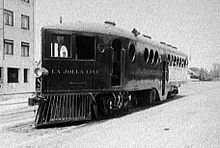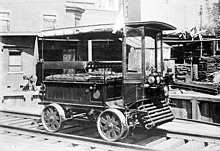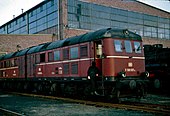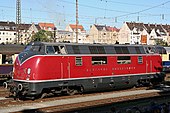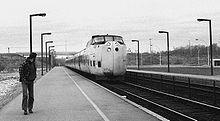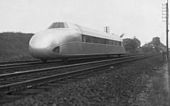History of the internal combustion engine drive in rail vehicles
This article deals with the history of internal combustion engine propulsion in rail vehicles from its origins to the mid-20th century.
As of 2010, around 80 percent of the global rail network was not electrified . Now that the steam locomotive era has come to an end in most countries of the world , traffic on the non-electrified railway lines is largely handled by internal combustion engine drives , especially in the diesel engine variant, due to the lack of other much more common drives . The diesel engine is thus the most common modern drive in rail vehicles, at least according to the extent of the route it touches .
On the other hand, a rating in favor of the competing electric drive could result if either the electrically operated local transport systems were included in the comparison or the transport services were compared.
For the first combustion engine vehicles , a “benzene engine” is often given as the drive. The use of benzene was as fuel for gasoline engines very common with high compression in the 1910s and 1920s. A "benzene engine" is therefore always a gasoline engine. The reasons for the later switch to gasoline as gasoline were mainly its lower costs and the later recognized health risk from benzene emissions.
From 1880: first attempts
The first rail vehicle with a combustion engine is considered to be a belt-driven tram locomotive built by Hanomag in 1880 . The drive unit developed 2.2 kW with a two-stroke engine weighing about a ton . In 1891 Daimler presented a narrow-gauge locomotive powered by a 2.9 kW petrol engine .
From 1890: railcars with gasoline engines and electrical power transmission

Forerunners of the diesel-electric drive of rail vehicles were drives with gasoline engines as the first energy converter, which were also called benzene-electric, petrol-electric or gasoline-electric drives. The American Patton had built a gasoline-electric locomotive as early as 1892, and three years later the Deutz gas engine factory was followed by a motorized locomotive with electric power transmission, which remained a one-off.
In the United Arad-Csanáder Railways in Hungary , from 1903 gasoline-electric railcars from Weitzer (Arad) with an internal combustion engine from the French manufacturer De Dion-Bouton were systematically used for passenger transport . The route is in the Banat and since 1919 in Romania .
Between 1907 and 1915, the Prussian State Railways produced a total of 22 multiple units of different designs, each with primary energy generation from gasoline engines fed with benzene to drive the vehicle's internal generators , which in turn supplied the electrical power for the electric traction motors. They had the series designation VT 151 , VT 21 (one vehicle each) and VT 152 to VT 161 (first series with ten vehicles, redesignated in 1913 as VT 1 to VT 10 , and the second series with ten vehicles VT 11 to VT 20 - in total 20 vehicles). They were mostly single vehicles with driver's cabs at both ends, a later series could be coupled with a separate, motorless control car if required .
A benzene - electric two-power locomotive , built in ten copies by Hanomag and Siemens for the South African Consolidated Diamond Mines, dates back to 1925 . It could run with a normal pantograph under the 500 V DC overhead contact line, as well as be supplied with a gasoline engine generator set with 200 HP (147 kW) power under the overhead line works railway lines.
From 1936 to 1939, the ČSD operated the express connection "Slovenská Strela" (German: Slovak arrow) on the Prague – Bratislava route with the ČSD M 290 railcar from the manufacturer Tatra. Its drive, designed by Josef Sousedík, worked with power split. The electrically transmitted part of the power decreased with increasing speed. From 85 km / h the generator was bridged and the power was only transferred mechanically.
From 1902: railcars with gasoline engines and mechanical power transmission
The "mechanical" transmission of the rotary motion of gasoline or benzene-powered gasoline engines to the wheels or axles was done, for example, with chain transmission and friction wheels as well as clutches from automotive technology. This type of transmission was only practicable for small outputs and was therefore only used with the first, mostly smaller, gasoline engines in rail vehicles. In some cases, only motor vehicles with railway wheels and railway signaling devices were retrofitted.
1900 to 1910
The kkStB 19.0 (initially referred to as Z 1 ) was the first Austrian internal combustion engine railcar of the kk Austrian State Railways . The two-axle vehicle was delivered in 1902 with the structural parts from Ringhoffer in Prague- Michov and equipped with an engine from Austro-Daimler in Wiener Neustadt . The driving performance and the mechanical clutch were not so convincing in operation, so that kkStB 19 was converted into an ordinary passenger car ten years later .
In 1904 the Werdau wagon factory delivered a two-axle motorized wagon to the Royal Saxon State Railways . It was listed as Type Dai 1 . The motor supplied by Austro-Daimler in Wiener Neustadt was located in the middle of the passenger compartment and transmitted the rotary movement to an axle via a mechanical gear. The engine was started with gasoline , while the engine was running, alcohol was fed in as fuel. Nothing is known about the planned use of the car.
William McKeen produced from 1905 in Omaha in the US state of Nebraska streamlined railcar, their engines and gearbox derived from ship engines. 152 of these McKeen railcars were built there from 1905 to 1917 and sold to over 40 US and four foreign railroad companies.
In the UK , the first motorized, petroleum- powered railcar is introduced by James Sidney Drewry in 1906 , made by Drewry Car Co.
From 1908 there is a photo of a two-axle, open rail car ( rail omnibus ) with gasoline engine drive on the rails of the New York Central Railroad .
1911 to 1920
In the period before the First World War , the upgraded Royal Saxon State Railways one of their buses of the type Daimler DC 3 c tentatively to the rail vehicle. The vehicle received iron-tyred wheels with flanges and the necessary signaling devices for railway operations. Nothing is known about a scheduled use, it was probably restored to its original condition after a few test drives.
In 1919, the Hetch Hetchy Railroad ordered a rail vehicle based on a standard truck chassis from the White Motor Company from A. Meister & Sons in Sacramento . The vehicle, which was completed in 1920, contained the power unit and rail brakes. The San Francisco Municipal Railway also installed a turntable in the vehicle, which made it possible to turn the vehicle and thus the direction of travel on the rails . The Railcar No. 19 could carry 13 passengers, but was primarily designed as an ambulance vehicle to transport the injured or dead to the hospital in Groveland . The vehicle was preferred by the Hetch Hetchy Project Manager, Chief O'Shaughnessy, for inspection drives from San Francisco . It reached a speed of 50 mph (about 80 km / h) and could travel 16 miles on a gallon of fuel. Railcar No. 19 thus set standards for five other vehicles, all of which were, however, built differently.
1921 to 1930
The petroleum-powered CPH rail engine was delivered to the New South Wales Government Railways in 1923 for branch line operations. It had a mechanical three-speed gearbox that was shifted with a massive lever from the driver's cab.
Shortly after starting operations in 1925, the former Furka-Oberalp-Bahn was looking for a cost-effective alternative to vehicles in order to be able to do without the labor- intensive use of steam locomotives in times of low traffic . In 1927, the Schweizerische Industrie-Gesellschaft (SIG) in Neuhausen procured two two-axle railcars especially for winter use . The chassis and engines were manufactured by the Swiss Lokomotiv- und Maschinenfabrik (SLM) in Winterthur and run as the BCm 2/2 railcar series . They were narrow-gauge vehicles with a gasoline-powered eight - cylinder boxer engine with an output of 110 kW and a firmly coupled, combined adhesion and gear drive .
In 1925 the Warchalowski, Eissler & Co company delivered a gasoline-mechanical, two-axle multiple unit with the registration number BBÖ VT 10 to the Austrian Federal Railways (BBÖ) . With this, the operation on branch lines should be handled efficiently. This was the first combustion railcar of the BBÖ. Also in 1925 the DWK delivered a four-axle railcar with the number BBÖ VT 20 to the BBÖ .
In 1926 the Deutsche Reichsbahn procured four two-axle "heavy-duty benzene railcars" of the DR 701 to 704 series with a large compartment for 50 people. The machine system was made up of standard truck parts. Only the electro-pneumatic control of the engine and transmission was a development by AEG . The mechanical gearbox WG 70 of the National Automobile Society was similar to the Mylius gearbox . The railcars were used primarily at the Frankfurt (Oder) , Pyritz and Meseritz depots . At the beginning of the war in 1939, the vehicles were initially shut down, but were used again after being converted to LPG . The four-axle DR 755 to 756 railcars acquired in the same period were basically similar, but with a larger passenger compartment and a drive motor in each of the two front cabs. However, both engines could be controlled simultaneously from one driver's cab.
Railcars with gasoline engines and mechanical power transmission were most widespread in Czechoslovakia. The company Tatra-Werke AG, automobile and wagon construction , delivered a total of 191 vehicles in several series to the Czechoslovak State Railways (ČSD) between 1928 and 1937 . Because of their distinctive central driver's position in a pulpit on the vehicle roof , they have become known as the Tatra tower cars .
From 1912: vehicles with diesel engines and mechanical power transmission
On September 11, 1912, the so-called Diesel-Sulzer-Klose thermal locomotive was completed as the world's first large diesel locomotive. It was commissioned in 1909 by the administration of the Prussian State Railways . This was preceded by an offer from the company for thermal locomotives, Diesel-Klose-Sulzer GmbH, founded by Rudolf Diesel , Adolf Klose and the Sulzer brothers .
The basic construction was a vehicle with two laterally displaceable running axles at the front and rear and a central pair of driving axles with rod drive, the axle sequence was thus 2'B2 '. There was a driver's cab in front and behind.
The drive was a four-cylinder V-two-stroke diesel engine with an output of 1200 hp (corresponding to 882 kilowatts), which was installed in the middle across the direction of travel. The connecting rod of this engine acted directly on cranks of a likewise centrally arranged transversely blind shaft . From the jackshaft, in turn, coupling rods went from both sides to the drive wheels on the two drive axles. To start up from standstill, compressed air was fed into the drive cylinders until a speed of 8 to 10 km / h was reached. Then the engines went into combustion mode. For this start mode, the locomotive had two 184 kW auxiliary diesel motors to refill the compressed air tanks and to drive the pumps for ancillary operations. After an initial trial run in the vicinity of the Sulzer machine factory in Winterthur, the locomotive was transferred to Berlin-Grunewald on April 4, 1913 , where further trial runs were made. Initially, there was some damage to the drive shaft and engine cylinder. The planned operation required short-term successive stopping and starting processes; It turned out that the required compressed air for the start of the auxiliary diesel was not topped up quickly enough, which resulted in longer holding times. When the war broke out in 1914, the tests were ended and the locomotive was scrapped.
After two years earlier successfully developed a diesel-electric locomotive for the Soviet Union was built and delivered in 1926 again under the direction of Yury Lomonosov , allegedly on personal instructions of Lenin in the German Hohenzollern Locomotive Works developed a diesel locomotive with time mechanical power transmission. It was initially listed as locomotive number Юм005, later the name was changed to Эмх3 (German transcription E mch 3). The machine was built with a 2'E1 'axle arrangement and a common rod drive for the wheels. Allegedly, the mechanical power transmission between the diesel engine and the wheels took place by coupling with an electromagnet. Because of its unreliable functionality, it turned out to be cheaper and more efficient to build locomotives with diesel-electric power transmission.
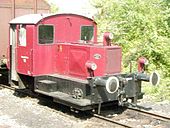
The DR small locomotive performance group I with low drive power (up to 40 hp) and diesel-mechanical drive was developed for light shunting tasks . While the DRG specified some dimensions as a standard for the locomotives of performance group II as early as 1931, it ordered the manufacturer types in performance group I from 1931 to 1934 in order to keep the purchase price low. These locomotives were supplied by Jung , Orenstein & Koppel , Windhoff and Gmeinder .
Below this DR small locomotive, performance group I , there were so-called “tractors” or “shunting tugs” which, although their performance would have fit into this class, had no route authorization. Examples are the Breuer locomotives , which were built in a total of almost 1000 pieces and were used in many countries.
Between 1932 and 1942, the Humboldt-Deutz works produced a total of 176 Deutz OMZ 122 R locomotives with axle formula B with diesel-mechanical drive for works railways. They had an engine output of 31 kW (40 hp) and a four-speed gearbox with mechanical power transmission.
The M 130.3 series version of the Czechoslovak Tatra tower car, last launched from 1933, had a 120 hp diesel engine instead of a gasoline engine and otherwise also the power transmission via a planetary gear.
In 1936, the diesel-mechanically operated Wehrmacht WR 220 locomotive was procured as a shunting locomotive for the German Air Force . The type WR 220 B had two axles, the type WR 220 C three, the wheel drive of which was carried out jointly via a jackshaft and with coupling rods. Both versions were manufactured by Deutsche Werke Kiel (DWK). The German Federal Railroad took over 14 of these locomotives as class V 22
Between 1936 and 1939, the Ardelt works in Eberswalde and Wilhelmshaven produced a total of 54 locomotives with axle formula B with diesel-mechanical drive for works railways. They had engine outputs between 59 and 132 kW (80–180 hp) and reached a top speed of 60 km / h.
In the following years, more and more similar small locomotives with diesel engines and mechanical power transmission for works railways and shunting services were built.
From 1912: diesel-electric drive
A diesel-electric drive is a machine configuration in which a diesel engine drives a generator that generates the electrical current for the actual traction motors . This configuration is often used in diesel locomotives and diesel railcars because they have a relatively simple construction, are less prone to failure and the driving performance can be easily controlled, regardless of the operating state of the diesel unit. As of 2012, the diesel-electric drive is the most common type of traction for rail vehicles worldwide. A less common type of drive with high-performance diesel engines is the diesel-hydraulic drive .
First diesel-electric railcars
Two diesel-electric railcars were built at ASEA in Sweden in the summer of 1912, in which a diesel engine with 75 HP (55 kW) supplied two parallel-connected DC traction motors via a 50 kW direct current generator, which in turn drove the axles via pivot bearings . On this basis, three railcars were built for the Prussian-Hessian state railways ( VT 101 to 103 ) and two almost identical DET 1–2 specimens for the Royal Saxon State Railways . Just like the previously built Prussian VT 2, the diesel engine and the generator were located here in a porch above the first, here three-axle bogie of the five-axle railcars, which could also be coupled with a control car .
Developments in express traffic
From the 1930s diesel-electric multiple units were used in express traffic, in Germany with the "Flying Hamburger" from 1932 (later DB class VT 04.0) of the Deutsche Reichsbahn Gesellschaft (DRG). This was also the first streamlined train in scheduled use. From 1933 it was used to establish the world's fastest train connection between Berlin and Hamburg . The multiple unit , consisting of two coupled car halves , was ordered by DRG in February 1932 from Waggon- und Maschinenbau AG Görlitz ( WUMAG ). It was delivered at the end of 1932 and accepted in February 1933.
A test drive on December 19, 1932 between Lehrter Bahnhof and Hamburg Hauptbahnhof was set by the express railcar with a speed record. The train covered the 286 km distance in 142 minutes .
New to the Flying Hamburger were the streamlined shape , which was developed in wind tunnel tests , the lightweight construction and the diesel-electric drive . Each of the two cars had a Maybach - twelve-cylinder - diesel engine G05 with connected DC generator and electrical Tatzlager traction motors . With an output of 2 × 420 PS (2 × 302 kW), a top speed of 175 km / h was achieved in test drives; a maximum speed of 160 km / h was set for scheduled use. The Maybach engine in its final stage of development as the GT06 is still used today in various locomotives of the DB class V 60 .
The DRG 877 was a prototype for other express railcars:
- the 2-part Hamburg type DRG 137 149 to 152 and 137 224 to 232 , as well as types derived from it:
- the 3-part type Leipzig DRG 137 153 to 154 and 137 233 to 234
- the 3-part type Cologne DRG 137 273 to 278 and DRB 137 851 to 858
- the 4-part type Berlin DRB 137 901 to 903
- the 4-part design Munich DRG 137 904 to 911 (no longer realized due to the war events)
The railcar was parked during the Second World War . From 1945 it was used as a passenger train by the French occupying forces and returned to the Deutsche Bundesbahn in 1949, which modernized it in 1951, among other things, it received Scharfenberg couplings at both ends so that it could be used with the other VT 04s. The railcar was parked in 1957.
In the USA, too, this drive was subsequently applied to streamlined vehicles , which at that time were the fastest rail vehicles ever on the American continent.
First diesel-electric locomotives

From 1919 onwards, the Russian transport scientist Yuri Wladimirowitsch Lomonossow headed a foreign trade commission in the German Reich. In this context, he obtained extensive information about locomotive construction in Germany. Finally, he decided to work with a team of engineers and scientists to design a diesel locomotive with electric power transmission for use on the Trans-Siberian Railway . As a result, from 1923 to 1924 a machine with the axle sequence type 1'Eo 1 'was built in the Esslingen machine factory. Wolfgang Messerschmidt writes about the genesis: “Lomonosoff finally ordered on his own from Hohenzollern AG in Düsseldorf. Fortunately, the approach was subsequently approved by the Council of People's Commissars. But when the French occupation of the Rhineland began in 1923, Lomonosoff made an additional agreement with Hohenzollern, according to which the construction of his favorite child - the diesel-electric locomotive - was assigned to the Esslingen machine works. "
The diesel engine used for this, with an output of 1200 HP (882 kW), drove a direct current generator with an output of 800 kW, with whose electrical energy the five traction motors connected in parallel were operated. In the spring of 1924, the finished locomotive was successfully tested in the factory and transferred to test runs on the broad gauge lines of the Soviet railways. Then the machine was taken over in February 1925 under the designation Юэ 001 in the inventory of the Soviet railways. This locomotive is considered to be the first operational main-line diesel locomotive in the world. Despite the satisfactory performance, this type was not mass-produced.
In the Baltic plant in St. Petersburg , the diesel-electric locomotive Щэл1 for the Soviet Railways (SŽD) was completed on August 5, 1924 . According to the designs of Jakow Modestowitsch Gakkel , it was built with 10 driving axles, each with its own drive motors. These were distributed over 3 (bogie) frames, which resulted in the rare axle sequence 1 'Co' Do Co '1' with the central arrangement of four driving axles (assuming that the wheels themselves were also movably mounted). The power of the diesel engine is given as 1000 hp. The machine was used from 1925 to 1927 on the Moscow - Kursk route and in the Caucasus . Due to frequent repairs, from 1934 it was only used as a power station to supply electricity.
One of the first companies to bring diesel-electric locomotives to market on a large scale was the American Locomotive Company (ALCO). 30 of their boxcabs , built between 1925 and 1928, are considered to be the first commercially successful diesel locomotive types. They had a generator for 600 volts direct current and four traction motors with a total output of 220 kW . In 1931, ALCO began series production of the HH series, of which 177 units were built. They had an output of 450 kW.
In 1941, the double locomotives of the type D 311 were built for the German Wehrmacht , each with eight diesel-electric wheel sets with the Do + Do wheel arrangement and an output of twice 660 kW = 1,320 kW. The four pairs of locomotives built were supposed to be used to move and maneuver the heaviest railway guns of the Wehrmacht.
Further developments in freight transport
Various configurations of diesel locomotives were developed, especially in the USA .
The most common type of diesel locomotive in the USA was initially the so-called cab unit with two elevated driver's cabs at both ends of the wide car body. This type is still the most common in Europe today.

In the 1930s to 1950s, the concept of "A and B units" emerged in the USA, with the "A-units" machines having only one driver's cab and a smooth rear wall and the "B-units" those without a driver's cab smooth ends were. With this configuration it was possible to combine services of any amount by combining a corresponding number of "B-Units" with one "A-Unit".
With the cab units as well as the A / B units, the poor view to the rear of the train was viewed as a disadvantage; the realization that the more cost-effective construction of the B units was not profitable compared to the reduced operational capability the lack of the driver's cab. This led to the development of the shape of the “hood units” with wide individual driver's cab with rear windows with a view along the hood, which is close to the engine. The concept of A and B units was only retained for longer on the long routes in the western United States . The last time "B-Units" were ordered from the Atchison, Topeka and Santa Fe Railway in the USA was in 1991. However, it is being discussed to use “B-units” again, which could be radio-controlled and maneuvered on the machine without personnel.
The technical highlight in European diesel locomotive construction with electrical power transmission were the 2940 kW (4000 hp) locomotives of the DR class 142 , which were delivered to the GDR in 1977/78 by the Voroshilovgrad locomotive factory ; they were surpassed in 2006 by the Voith Maxima built in Germany with hydrodynamic power transmission and an output of 3,600 kW (4,896 PS). The most powerful diesel locomotives to date, however, were the American diesel -electric Do'Do ' EMD DDA40X machines with an output of 4,920 kW (6,690 hp) built in 1969 by Electro-Motive Diesel for the Union Pacific Railroad .
1927: Locomotive with diesel engine and pneumatic transmission
In 1924, the DR placed an order for the development of a powerful diesel locomotive for passenger train service. A pneumatic system with a downstream air compressor was used to transmit power from the 6-cylinder diesel engine from the submarine building to the drive wheels , which is based on the mechanical principle of the steam locomotive drive with two drive cylinders and three coupled drive axles (wheel arrangement 2'C2 ' ) equaled.
The vehicle was completed in 1927 and put into service in 1929 after test drives as the V 3201 at the Reichsbahndirektion Stuttgart . In 1930 it was redrawn as V 120 001 . However, it did not prove its worth, as the thermal energy that was additionally supplied when the compressed air was compressed using the engine exhaust gases was lost too quickly due to cooling. So this locomotive was taken out of service again in 1933. As a successor, the V 140 001 with hydraulic power transmission was developed.
From 1934: diesel-hydraulic drive
A diesel-hydraulic drive is a machine configuration in which a diesel engine acts on a fluid transmission that transmits the rotation of the drive shaft of the diesel engine to the wheels. This configuration is preferred especially in Germany because it weighs less than the diesel-electric drive.
First diesel-hydraulic locomotives
In 1934, the Deutsche Reichsbahn commissioned the development of a diesel locomotive with a hydrodynamic transmission and an output of over 1000 kilowatts. According to the specifications for the performance and the maximum speed, the Reichsbahn-Zentralamt in Munich, with the participation of the companies Krauss-Maffei , Voith and MAN, designed the V16 101, numbered from 1936 as DR V 140 001 . It had the axle arrangement 1'C1 ', with a rod drive of the three driving axles , a weight of 83 tons, reached a top speed of 100 km / h with a continuous output of 1030 kW (1400 PS).
As a result, when the Second World War began , there were other types of diesel locomotives, primarily for military purposes, all of which (with the exception of the Wehrmacht D 311 locomotive ) were diesel-hydraulically powered: the narrow-gauge army field railway locomotives of the types HF 130C and HF 200 D , as well as the Wehrmacht locomotives of the Types WR 200 B 14 , WR 360 C 14 and WR 550 D 14 . Both the Heeresfeldbahn locomotives and the Wehrmacht locomotives had a cuboid engine front end with a four-stroke diesel engine in front of the driver's cab , which drives a jackshaft via a fluid transmission from Voith, on which the drive wheels are rotated together via a coupling rod . The engine outputs were 130 to 550 hp, the top speeds 30 to 55 km / h.
The DB class V 80 was the first newly developed diesel locomotive of the German Federal Railroad for line service. The series was built in 1952 in a number of only 10 copies, but formed the basis of all further developments of the DB in this sector.
The DB series V 200.0 , built in 1953, was the first large series of diesel mainline locomotives for the Deutsche Bundesbahn. It became very well known abroad with its distinctive industrial design shape from the 1950s. It had two V12-cylinder diesels with a continuous output of 2200 hp - from which the series designation V 220 resulted. The technology of the V 200 was continued with the DB series V 160 and its later variants.
In the 1960s, a few versions of diesel-hydraulic mainline locomotives appeared outside of Europe, but there was no successor, such as the ALCO DH-643 or the Krauss-Maffei ML 4000 C'C ' in the USA, which was manufactured in Germany . In Germany, diesel-hydraulic locomotives are currently still being built by MaK , Voith and Vossloh for private and works railways. With the locomotives of the Voith Maxima series built in Germany in 2006 with hydrodynamic power transmission and outputs of almost 3600 kW (corresponding to 4900 hp), a preliminary high point in development in diesel locomotive construction was reached.
First diesel-hydraulic railcars

After the Second World War, the Deutsche Bundesbahn used the DB class VT 08, built in 1952, with high-speed railcars with diesel-hydraulic drives. It was initially used as a three-part, later also as a four-part multiple unit with non-powered intermediate and control cars. The first order consisted of 13 three-part trains.
In 1957, the diesel-hydraulically operated DB series VT 11.5 followed for international TEE traffic with increased comfort. At that time it was the parade train of the Deutsche Bundesbahn. A total of 19 machine cars, 23 compartment cars, eight open seating cars , eight dining cars and nine kitchen cars were delivered for this train class.
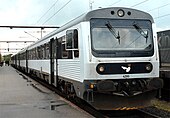
In the 1970s, the railcars of the DB class 627 and DB class 628 , the Danish DSB MR and, in the late 1990s, the multiple unit series Siemens Desiro Classic and DB class 612 were typically designed by German companies ( Waggonfabrik Uerdingen and Siemens Mobility ) built.
From 1938: rail vehicles with gas turbine drive
Locomotives were repeatedly equipped with gas turbines either as a sole or additional drive. Gas turbines had the advantage that they could be operated with cheap heavy oil and that very high outputs were possible with the same vehicle weight. At the end of the 1960s, however, changes in the oil refineries increased the production costs for heavy oil and the operation of gas turbine vehicles became uneconomical.
In many cases, gas turbine vehicles were built as individual prototypes or converted series vehicles. This happened for the first time in Switzerland in 1938 with the gas turbine locomotive SBB Am 4/6 . Only in three cases were there larger series and use of pure gas turbine vehicles. There were a total of 56 trains of the SNCF Turbotrain in various designs, the Union Pacific Railroad had the world's largest number of gas turbine locomotives with a total of 55 UP gas turbine locomotives, which were built in three series by Alco-GE for the transport of goods over long distances from 1948 , and the North American UAC TurboTrain .
Eight class 210 locomotives with switchable gas turbines were in use on the Deutsche Bundesbahn after the technology had been tested with the V 169 001 .
Rail vehicles with drives from the aviation industry
In 1929 the engineer Franz Kruckenberg built the so-called Schienenzeppelin , a one-piece vehicle with a propeller attached to the internal combustion engine . There were different tests on the same vehicle. During a test drive, a world speed record of 230 km / h was set for rail vehicles of the time.
The French Aérotrain from 1965, on the other hand, had a jet engine , various test vehicles carried out several thousand journeys on the test routes and set several international speed records. However, it did not come into commercial use.
Individual evidence
- ^ The World Factbook 2011. Retrieved March 6, 2012 (English).
- ↑ Mobility for the gasoline engine. ( Memento from July 24, 2014 in the Internet Archive ) Daimler press release, June 2008.
- ↑ Alexander Stock: Railcar.
- ^ Josef Ernst: The history of the gasoline engine at Mercedes-Benz. June 2008, p. 11.
- ↑ H. u. B. Michaelsen: Diesel locomotive.
- ↑ a b c d K. Matthias Maier: The diesel locomotives at the DB. History - development - commitment. Franckh'sche Verlagshandlung, W. Keller & Co., Stuttgart 1988, ISBN 3-440-05870-0 , p. 8 .
- ^ Electric railways, VII. Automobile railcars. In: Early v. Röll: Encyclopedia of the Railway System. 1912.
- ↑ a b VT 1 to VT 103. In: Prussia Report. Volume 9, Hermann Merker Verlag, Fürstenfeldbruck 1996, ISBN 3-922404-84-7 .
- ↑ Railtown 1897 State Historic Park Railway Museum
- ^ Diesel-Sulzer-Klose thermal locomotive. In: Schweizerische Bauzeitung. Volume 62, Issue 22, 1913.
- ^ Klose Sulzer diesel thermal locomotive. In: Prussia Report. Volume 9, Hermann Merker, Fürstenfeldbruck 1996, ISBN 3-922404-84-7 , p. 40.
- ↑ Walther Fischer: Klose, Adolph. In: New German Biography (NDB). Volume 12, Duncker & Humblot, Berlin 1980, ISBN 3-428-00193-1 , pp. 121-123 ( digitized version ).
- ^ Sulzer Brothers History & Production Details For Rail Traction
- ^ Wolfgang Messerschmidt: From locomotive to locomotive. Esslingen and locomotive construction for the railways of the world. Franckh'sche Verlagshandlung, 1969, p. 133 ff.
- ↑ Image: The E_el-2 after the first test in Esslingen, November 6, 1924. The designers and guests are there. Photo: Unknown author. Scan by Oleg Izmerov
- ↑ Railway Museum St. Petersburg ( page no longer available , search in web archives ) (PDF; 140 kB)
- ↑ M. Weisbrod, D. Bäzold, HJ Obermayer: The large type Book German locomotives . Transpress Verlag, 1994, ISBN 3-344-70751-5 .
- ↑ Data and pictures of the V 120 001
literature
- J. Feihl: The diesel locomotive - construction, technology, design. Transpress-Verlag, Stuttgart 2009, ISBN 978-3-613-71370-3 .
- Bernd Friedrichs, Andreas Stange: The light-incineration railcars (LVT) of the Deutsche Reichsbahn: VT 2.09 (BR 171/172, 771/772) and VT 4.12 (BR 173). 1st edition. Ek-Verlag, 2010, ISBN 978-3-88255-231-7 .
- Raimo Gareis: German diesel locomotives from yesterday. Diesel locomotives of the Deutsche Bundesbahn, the Deutsche Reichsbahn and some private railways. Krone, Lünen 2001, ISBN 3-933241-36-7 .
- Wolfgang Glatte: German Locomotive Archive: Diesel Locomotives . 4th edition. transpress, Berlin 1993, ISBN 3-344-70767-1 .
- Markus Hehl: German diesel locomotives. (= Railway Courier Special. 72). EK Verlag, Freiburg, ISSN 0170-5288
- Günther Klebes: The electric and diesel traction vehicles at the railway technology exhibition in Seddin on the occasion of the railway technology conference in Berlin from September 21 to October 5, 1924. (= monographs and communications. Series 20). (Double booklet). Published by the German Society for Railway History eV, Karlsruhe 1978, ISBN 3-921700-18-3 .
- Jurij V. Lomonosov : Diesel locomotives. VDI-Verlag, Berlin 1929. (Reprint edition Düsseldorf (VDI-Verlag)), 1985.
- Jurij V. Lomonosov: The diesel-electric locomotive. Translated from d. Soot. by Erich Mrongovius. VDI-Verlag, Berlin 1924.
- P. Ostertag: The first thermal locomotive . In: Schweizerische Bauzeitung . tape 62 , no. 22 , 1913, doi : 10.5169 / seals-30819 ( online [PDF; 4.2 MB ]).
- Prussia Report. Volume 9: Klose Sulzer diesel thermal locomotive. Hermann Merker, Fürstenfeldbruck 1996, ISBN 3-922404-84-7 , p. 40.



